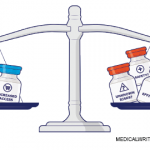
Should patients with rheumatic diseases switch from a biologic to its biosimilar?
Lightspring / shutterstock.com
SAN DIEGO—Should patients with rheumatic diseases switch from a biologic to its biosimilar? At the 2017 ACR/ARHP Annual Meeting’s Great Debate, held Nov. 5, two rheumatologists argued whether to switch or stay put based on safety, efficacy and potential cost savings.
First to the podium to make the case for switching, Jonathan Kay, MD, tweaked Shakespeare’s Hamlet: “To switch or not to switch, that is the question! Whether ’tis better for bones and joints to suffer the stings and burden of outrageous prices, or try changing to a biosimilar and, by converting, save costs. That is the question,” said Dr. Kay, professor of medicine at the University of Massachusetts Medical School in North Worcester. “The data support that it is safe, effective and cost effective to switch to a biosimilar.”
Rigorous Approval
Biosimilars approved in the U.S., such as infliximab-dyyb (Inflectra), adalimumab-atto (Amjevita), adalimumab-adbm (Cytelzo) and etanercept-szzs (Erelzi), go through an abbreviated development process, which decreases cost. These drugs are still required to meet rigorous standards and complete extensive comparisons with their reference product, or bio-originators, for approval, he said.
All biologic products may vary from batch to batch due to small changes in the manufacturing process or such factors as oxidation, Dr. Kay noted.1 As long as any variation is within proved, acceptable ranges for critical quality attributes, these products are approved and pose no safety or efficacy risks. One 2011 study showed changes in batches of both etanercept and rituximab after shifts in manufacturing processes over a four-year period.2 Despite these differences, the products were within acceptable ranges of variation, so no label changes or further analytic data studies were required.
Manufacturing variability may make one batch of a reference biologic essentially a biosimilar of another batch, said Dr. Kay. A biosimilar must demonstrate similar safety and efficacy in comparison to its reference product, but “there is no need to demonstrate efficacy in all indications, because we have extensive clinical experience with the reference product. No differences are expected in purity or safety between an approved biosimilar and its reference product.”
Comparable Safety & Efficacy
It’s safe and effective for patients to switch to a biosimilar, said Dr. Kay, citing several studies from Europe.
In a 52-week trial from Norway, 482 patients with six different inflammatory conditions—RA, psoriatic arthritis, psoriasis, Crohn’s disease, ulcerative colitis and spondyloarthritis—who were stable on infliximab were divided into a maintenance therapy group and a group switched to the biosimilar, infliximab-dyyb.3 Averaging across all six indications, treatment responses in the biosimilar group fell within the study’s 15% margin of non-inferiority to the bio-originator. The study also showed similar immunogenicity, or the development of anti-drug antibodies, in both groups, says Dr. Kay.
A study from Denmark compared disease worsening for patients with RA, PsA or axial SpA who either stayed on etanercept or switched to its biosimilar, SB-4.4 Both groups had similar disease activity. However, 8.3% of patients in the biosimilars group discontinued the drug during follow-up due to lack of effect or adverse events. This may be due to the “nocebo effect,” when some patients mistakenly attribute symptoms to a drug due to expectation of or past experiences with side effects or misconceptions about the drug, he said.
Lower cost is the driver for switching, Dr. Kay noted. With a nod to the 18th century Enlightenment philosopher Jean-Jacques Rousseau, Dr. Kay said, “we should accept a lower-cost biosimilar so that medications are more widely available to all members of society. The availability of multiple biosimilars for the same reference product will drive prices down.”
Data from one study cannot be generalized to all indications, & in the U.S., patients do not save money with a biosimilar. —Roy Fleischmann, MD, MACR
Counter: Where’s the Discount?
Roy Fleischmann, MD, MACR, clinical professor of medicine at the University of Texas Southwestern Medical Center in Dallas, countered that data from one study cannot be generalized to all indications, and that in the U.S., patients do not save money with a biosimilar.
“Are real, considerable cost savings realized with the use of biosimilars, that accrue to the patient, who would, therefore, have greater access to biologics? If you have a biosimilar that is not cheaper for the patient, and the patient does not have greater access, you don’t need a biosimilar,” he said.
Dr. Fleischmann flashed a slide with a large, bold statement, saying, “I couldn’t fit a bigger font on the screen to emphasize this point: If it isn’t considerably cheaper to the patients and society, there is no value in using a biosimilar.”
To illustrate that the case for switching to biosimilars is relatively tepid, Dr. Fleischmann turned to a consensus statement co-authored by his debate opponent, which includes principles and recommendations for biosimilar use graded on quality and level of evidence.5 Most of the items received low grades, Dr. Fleischmann said.
“One recommendation says that biosimilars must be much cheaper than the bio-original to the patient and healthcare system—I absolutely agree. They say they are cheaper. I’m going to show you that they’re not,” said Dr. Fleischmann. “If they’re not much cheaper, then why switch?”
Dr. Fleischmann queried the director of an infusion center network partially owned by his practice to find out if the infliximab biosimilar was used and, if so, whether it saves costs.
“[The director’s] answer was: ‘We’ve tried several times with multiple insurance plans. Unfortunately, the insurance plans have requested that the physician appeal, and we have not been approved even once to use a biosimilar. And from a patient cost perspective, the biosimilar DMARD costs roughly the same; there is a not a cost savings to the patient,” he said.
Biologic manufacturers’ rebates and discounts accrue to pharmacy benefit managers (PBMs) rather than patients in the U.S., said Dr. Fleischmann. Patent disputes among bio-originator and biosimilar manufacturers also stifle competition here, he said.
Dr. Fleischmann questioned non-inferiority data and the nocebo effect cited by Dr. Kay, and argued that the results from the same trials Dr. Kay cited demonstrated that non-inferiority of the biosimilar was not achieved compared to the bio-originator in the majority of indications tested in the Norwegian study and that a clinically meaningful number of patients did not respond adequately, or developed adverse events on the switch to the biosimilar in Denmark.3,4
“Nocebo is a word that comes up when you don’t get the result that you want to see,” he said. In biosimilar trials, 15–30% of patients discontinued the drug after switching, he said. “Not because of the adverse effects, but because they really didn’t have a clinical response. Do you want to call it a nocebo effect, or do you want to call it real life? It is an open question.” Later, in the question and answer section, Dr. Kay suggested that a nocebo effect could be avoided in real life if prescribers frame the switch from a bio-originator to a biosimilar in a positive light.
Are there any data to support the safety and efficacy of multiple switches among biosimilars, Dr. Fleischmann asked, then flashed a blank screen. “There is no evidence,” he said. “The potential effects of multiple switches have not been studied.”
Only reduced cost and greater therapy access for patients support the case for switching, Dr. Fleischmann said. “If I live in Norway, maybe I’ll take the risk. But if I live in the U.S., and I don’t get any benefit? My government doesn’t get any benefit? Only the insurance company benefits? I’m not taking that risk,” he said.
Rebuttals: The Rebate Trap
In his rebuttal, Dr. Kay noted that biosimilars are driving costs down in countries outside the U.S., so there is hope that patient access to all biologics will grow. In Norway, the healthcare system requires competitive bidding among manufacturers. In 2015, the bid price for Remsima, an infliximab biosimilar, was 69% lower than that of its bio-originator, he said.
The U.S. is in a rebate trap that keeps drug prices high across the system, Dr. Kay said.6 Payers who give biosimilars a preferred tier position on their formularies may then lose rebates from reference product makers, “so it’s only if virtually all of the patients go to the biosimilar does the rebate trap not affect the payer,” he said.
Payers in the U.S. give preferred positions only to the drugs that drive up their profits, not those that boost savings for patients, said Dr. Fleischmann.
“This is the reality of the situation. You can tell me what should be, but that isn’t happening right now. I’m not saying it’s correct, but it’s the reality,” Dr. Fleischmann said.
Susan Bernstein is a freelance journalist based in Atlanta.
References
- Kuhlmann M, Covic A. The protein science of biosimilars. Nephrol Dial Transplant. 2008 Oct 2006;21(suppl 5):v4–v8.
- Schiestl M, Stangler T, Torella C, et al. Acceptable changes in quality attributes of glycosylated biopharmaceuticals. Nat Biotechnol. 2011 Apr;29(4):310–312.
- Jorgensen KK, Olsen IC, Lorentzen M, et al. Switching from originator infliximab to biosimilar CT-P13 compared with maintained treatment with originator infliximab (NOR-SWITCH): A 52-week, randomised, double-blind, non-inferiority trial. Lancet. 2017 Jun;389(10086):2304–2316.
- Glintborg B, Sorensen IJ, Loft AG, et al. A nationwide non-medical switch from originator infliximab to biosimilar CT-P13 in 802 patients with inflammatory arthritis: 1-year clinical outcomes from the DANBIO registry. Ann Rheum Dis. 2017 Aug;76(8):1426–1431.
- Kay J, Schoels MM, Dorner T, et al. Consensus-based recommendations for the use of biosimilars to treat rheumatological diseases. Ann Rheum Dis. 2017 Sep. Epub ahead of print.
- Hakim A, Ross JS. Obstacles to the adoption of biosimilars for chronic diseases. JAMA. 2017 Jun 6;317(21):2163–2164.


